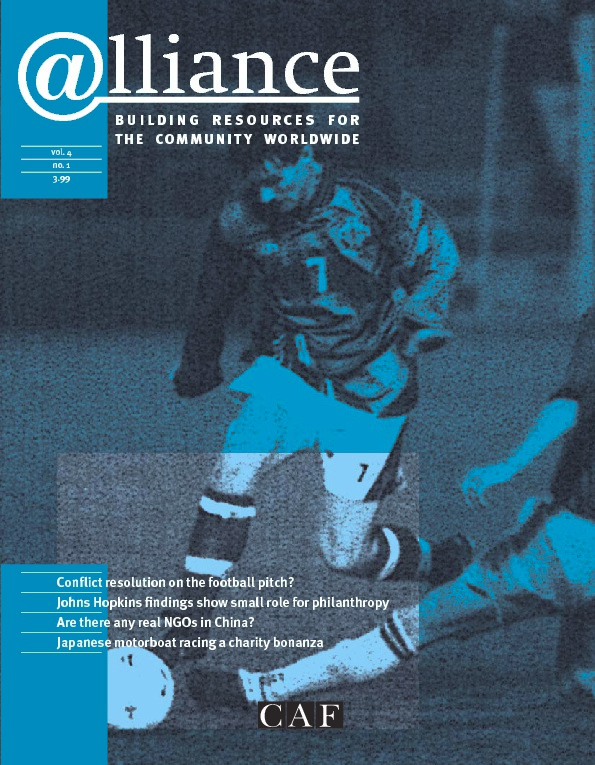An undoubted highlight of the EFC conference in Turin in November was the presentation by Lester Salamon of the key findings of Phase II of the Johns Hopkins Comparative Nonprofit Sector Project.
Salamon has been asserting for some time that a ‘global associational revolution’ is taking place, and the impressive figures he presented about the global size of the sector certainly bear this out. Almost 19 million people are now employed in the non-profit sector in the 22 countries studied, making it a US$1 trillion industry amounting, on average, to 4.7 per cent of GDP. Taken as a separate economy, it would be the eighth largest in the world, ranking ahead of Brazil and Russia.
Sector growth is particularly impressive. In the nine countries for which comparative figures were available, non-profit sector employment jumped 23 per cent between 1990 and 1995 compared to 6 per cent for employment growth in the economy as a whole.
The small role of philanthropy
Perhaps the most startling figures are those relating to the role of philanthropy itself. Non-profit sector revenue worldwide appears to derive overwhelmingly from fees and charges (47 per cent) and government funds (42 per cent), with a modest 11 per cent coming from philanthropic giving – by individuals, companies and foundations.
Moreover, the share of philanthropy appears to be shrinking. In the seven countries for which comparisons could be made, the dramatic growth in non-profit employment had been made possible largely by a rise in fee income (accounting for 58 per cent of revenue growth), with the public sector accounting for only 34 per cent and philanthropy for 8 per cent.
The share of philanthropy does increase from 11 per cent to 27 per cent when time contributed by volunteers is factored into the equation, but for those involved in philanthropy the figures are none the less sobering.
The lessons for private funders
According to Cornelia Higginson, responsible for Philanthropy Programs at American Express, the Johns Hopkins findings ‘inject a much-needed breath of realism into the funding community. Private philanthropy will never be able to deal with the massive problems faced by communities all over the world.’ So what role should private funders be playing? There are, she says, perhaps two key lessons:
- Private funders must focus on what they can do that is different – innovative pilot schemes.
- If they are not to be assigned to a marginal ‘research’ role, they must form partnerships with governments and multilateral funders in which they are involved in project design as well as delivery.
Regional and country differences
There are, however, huge regional and country variations. While non-profit employment accounts for almost 7 per cent of total non-agricultural employment in Western Europe and other developed countries, the figure for Latin America is only 2.1 per cent with 1.3 per cent for Central and Eastern Europe (CEE). If volunteer time is factored in, the gaps actually widen.
Particularly unexpected was the finding that in terms of non-profit employment the USA lags behind the Netherlands, Ireland, Belgium and Israel (7.8 per cent of total employment as opposed to 12.4, 11.5, 10.5 and 9.2 per cent, respectively).
Revenue sources also show huge regional variations. In all Western European countries except Spain public sector funding was the dominant element; this was most pronounced in Ireland and Belgium, where the public sector share was 78 and 77 per cent, respectively. In Latin America, CEE countries and developed countries outside Europe, fee income was generally dominant, with a figure of 85 per cent in Mexico.
In no country was private philanthropy the main revenue source for the non-profit sector, but in CEE countries overall it accounts for about a quarter of all revenues – very much higher than the global average. In Romania the figure is as high as 36 per cent. This probably reflects both a long tradition of enterprise financing of key services under Communism and significant philanthropic support from outside the region for the emerging non-profit sector.
Widening the geographical net
On 10–12 December, researchers from developing countries in Africa, Asia and the Middle East gathered at the Johns Hopkins Institute for Policy Studies in Baltimore to launch Phase IIB of the Comparative Nonprofit Sector Project. While new demands have increasingly been placed on non-profit organizations in the developing countries of Africa, Asia and the Middle East, knowledge about these organizations remains abysmally limited. Phase IIB will help close this gap in knowledge by expanding the project to include Ghana, Kenya, Tanzania, Uganda, India, Pakistan, the Philippines, South Korea, Thailand, Egypt, Jordan, Kuwait and Lebanon. Initial results are expected in the year 2000.
Although the uniqueness and value of the Johns Hopkins findings cannot be overstated, we should also be aware of their limitations. As international advisory committee member Miklos Marshall, founding Director of CIVICUS and a project adviser, points out: ‘This is an economic, statistical analysis; it describes an industry in terms of labour, revenue, outputs. But it does not look at the associational fabric of life where social capital is created.’
The initial Phase II findings are summarized in a short report entitled ‘The Emerging Sector Revisited: A summary’. To order, contact Wendell Phipps at the Johns Hopkins Center for Civil Society Studies.
Tel +1 410 516 4523
Fax +1 410 516 7818
E-mail jh_cnpsp@jhu.edu






Comments (0)